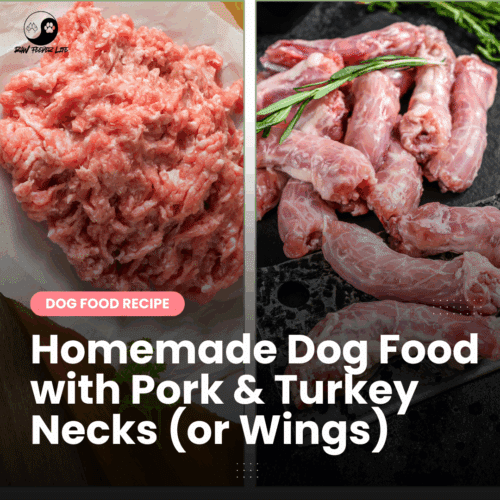Keep the Tail Wagging is supported by pet parents. I occasionally earn a commission (at no additional cost to you) when you click through an affiliate link to one of my favorite products. Thank you for your support. Read More
If you’ve been exploring ways to boost your dog’s health naturally, you’ve probably heard about omega-3 fatty acids. These healthy fats are superstars for everything from joint health to shiny coats, but there’s a lot of confusion about where to get them and how much dogs need.
Let’s break it down so you can confidently add this powerful nutrient to your dog’s diet.
Why Omega-3 Fatty Acids Matter for Dogs
Omega-3 fatty acids, especially EPA (eicosapentaenoic acid) and DHA (docosahexaenoic acid), are essential fats. Dogs can’t produce them in significant amounts, so they need to get them through food or supplements.
Here’s how omega-3s benefit your dog:
- Reduces inflammation: Helpful for arthritis, allergies, and inflammatory conditions.
- Promotes healthy skin and coat: Helps reduce dry, flaky skin and itchiness.
- Supports heart health: May help lower triglycerides and support cardiovascular function.
- Boosts cognitive function: DHA is crucial for brain health, especially in puppies and senior dogs.
- Supports kidney health: Can help reduce protein loss in dogs with kidney issues.
The Best Animal-Based Sources of Omega-3s for Dogs
Animal sources provide EPA and DHA directly, the most bioavailable forms for dogs. Some of the best options include:
- Sardines (fresh or canned in water)
- Anchovies
- Mackerel (small, low-mercury types)
- Salmon oil (wild-caught preferred)
- Herring
- Krill oil (higher antioxidant content but more expensive)
- Green-lipped mussel oil (also offers joint benefits)
These sources deliver pre-formed EPA and DHA, making them far more effective than plant-based options.
Why Plant-Based Omega-3s Aren’t Enough for Dogs
Plant oils like flaxseed, chia, or hemp seed oil contain ALA (alpha-linolenic acid), not EPA or DHA. Dogs’ bodies have to convert ALA into EPA and DHA, but the conversion rate is extremely low (often under 5%).
So while plant oils are not “bad,” they can’t replace animal-based omega-3s for therapeutic benefits.
Alternatives for Dogs Allergic to Fish
If your dog is allergic to fish, don’t worry – you have alternatives:
Green-lipped mussel oil – sourced from shellfish instead of finned fish, some dogs tolerate it better.
Krill oil – although still marine-based, it may be less allergenic for some dogs.
Emu oil – a terrestrial animal-based oil that contains small amounts of omega-3s (not as potent as marine sources but helpful).
Algae oil – a vegan, fish-free source of DHA. Suitable for fish-allergic dogs but typically lower in EPA.
There are tests available that can help you determine if your dog has a seafood sensitivity. You can also consult your vet or a certified canine nutritionist.
- 5Strands Pet Food Intolerance Test
- Glacier Peak Holistics, The Original Pet Intolerance Test
- NutriScan Pet Food Intolerance and Sensitivity Test
How to Balance Omega-3 and Omega-6 Fatty Acids
Modern dog diets (especially kibble) tend to be very high in omega-6 fatty acids. Too much omega-6 can fuel inflammation if it’s not balanced with omega-3s.
A simple way to help balance this ratio:
- Feed less processed food. Kibble and treats often contain omega-6-heavy oils (like sunflower or corn oil).
- Add an omega-3 supplement based on your dog’s weight (see chart below).
- Rotate fresh fish meals if your dog tolerates them.
The goal is an omega-6 to omega-3 ratio closer to 5:1 or even 3:1, rather than the typical 20:1 found in processed diets.
Omega-3 Dosage Chart for Dogs
Here’s a general guideline for daily omega-3 intake (combined EPA + DHA):
| Dog Weight | EPA+DHA per Day |
|---|---|
| Under 10 lbs | ~150 mg |
| 10–20 lbs | ~300 mg |
| 20–40 lbs | ~600 mg |
| 40–60 lbs | ~900 mg |
| 60–80 lbs | ~1200 mg |
| 80+ lbs | ~1500 mg |
Note:
- These doses are for therapeutic benefits (e.g., arthritis, inflammation). For general health, a lower dose may suffice.
- Check your supplement label for concentration (e.g., “per teaspoon” or “per capsule”).
- Always discuss changes with your veterinarian, especially for dogs with medical conditions or on medications.
How I Incorporate Omega-3s in My Dogs’ Diet
Omega-3 fatty acids are one of the most powerful tools you can use to support your dog’s health naturally. Choosing the right source and proper dosage can reduce inflammation, support brain and heart health, and keep your dog looking and feeling fantastic.
I alternate wild-caught salmon oil, fresh sardines, and a fatty fish blend with my dogs. I stopped feeding canned sardines because the cost adds up with four dogs. I follow the dosage recommendations on the bottle, adjusting as needed based on each dog’s individual needs. For instance, my senior dog gets slightly more than what’s recommended.
- Life Line Pet Products – wild-caught Alaskan salmon oil
- Oma’s Pride whole sardines
- Oma’s Pride Ocean’s Blend – Atlantic salmon, sardines, and mackerel
- Adored Beast Apothecary – Potent-Sea Omega-3 (algae oil)
Does your dog already get omega-3s in their diet? Let me know your favorite sources in the comments below!





